The Cambridge History of China. Vol. 13: Republican China 1912-1949, Part 2
Подождите немного. Документ загружается.


THE DECLINE OF KMT RULE 741
Rather
the
issue
was the
stigma officially attached
to the
re-education
process.
In
announcing
it, the
Ministry
of
Education asserted that
all
students who had attended schools
in
areas controlled by the collaborator
government were assumed
to
have been corrupted,
and
until they were
re-educated
and
their thoughts purged, they would
be
unfit
for
further
education.
As
' puppet students' they should
be
helped
to
' wash
off
their
ideological stains'.
21
But
with
the
public scandal created
by the
venality
of
the
newly-arrived officials from
the
south-west, local people initially
on
the
defensive soon rose
to
question
why
such individuals should
presume
to sit in
judgment
on
anyone.
Yet, despite its transgressions during this period, the KMT government
suffered little more than
a
loss
of
prestige
and
public confidence. There
were
few
calls
for
anything more drastic than
the
restoration
of
that
confidence through the correction of the errors committed. Unfortunately
for the government, most
of
the issues that aroused such disillusionment
after the Japanese surrender were never satisfactorily resolved, becoming
instead
a
prelude
for
what was
to
follow. Hence, what might have been
forgotten as
a
temporary postwar lapse came
to be
recognized afterwards
as
the
beginning
of the end of
popular urban support
for the KMT
government.
Economic incompetence: the policy of inflationary finance
Monetary inflation probably contributed more than any other single issue
during
the
civil
war
years
to the
loss
of
urban public confidence
in the
KMT's ability
to
govern. The policy
of
inflationary finance began during
the Anti-Japanese War when the government was
cut off
from the coastal
and Yangtze River cities which had been its main base
of
financial
support.
By 1945, government income,
not
including bank credits, equalled only
one-third
of
expenditures
and the
deficit was made
up
almost entirely
by
printing-press money.
In the
resulting inflation average prices rose over
two thousand times between 1937
and
August 1945.
The gap
between
government income
and
expenditure continued throughout
the
civil
war
years,
as did the
principal means
of
bridging
it,
while
the
effects
of the
ensuing hyper-inflation played themselves
out to
their inevitable
conclusion. Perhaps
the
most dangerous consequence
of
the decision
to
rely
on
printing press money
was
that
it
allowed those
who
made
it to
believe there
was an
easy solution
to the
nation's financial difficulties.
21
Cbung-mei jib-pao, Shanghai,
20
Nov.
194J
(CPR,
20
Nov.); also,
Sbib-sbib
bsin-pao,
Chungking,
12 Sept.
1945 (CPR, 12
Sept.);
Cbtmg-jangjib-pao,
Chungking,
12
Sept.
1945 and
Ta-hag-pao,
Chungking,
11
Sept. 194; (both
in
CPR,
13
Sept.).
Cambridge Histories Online © Cambridge University Press, 2008
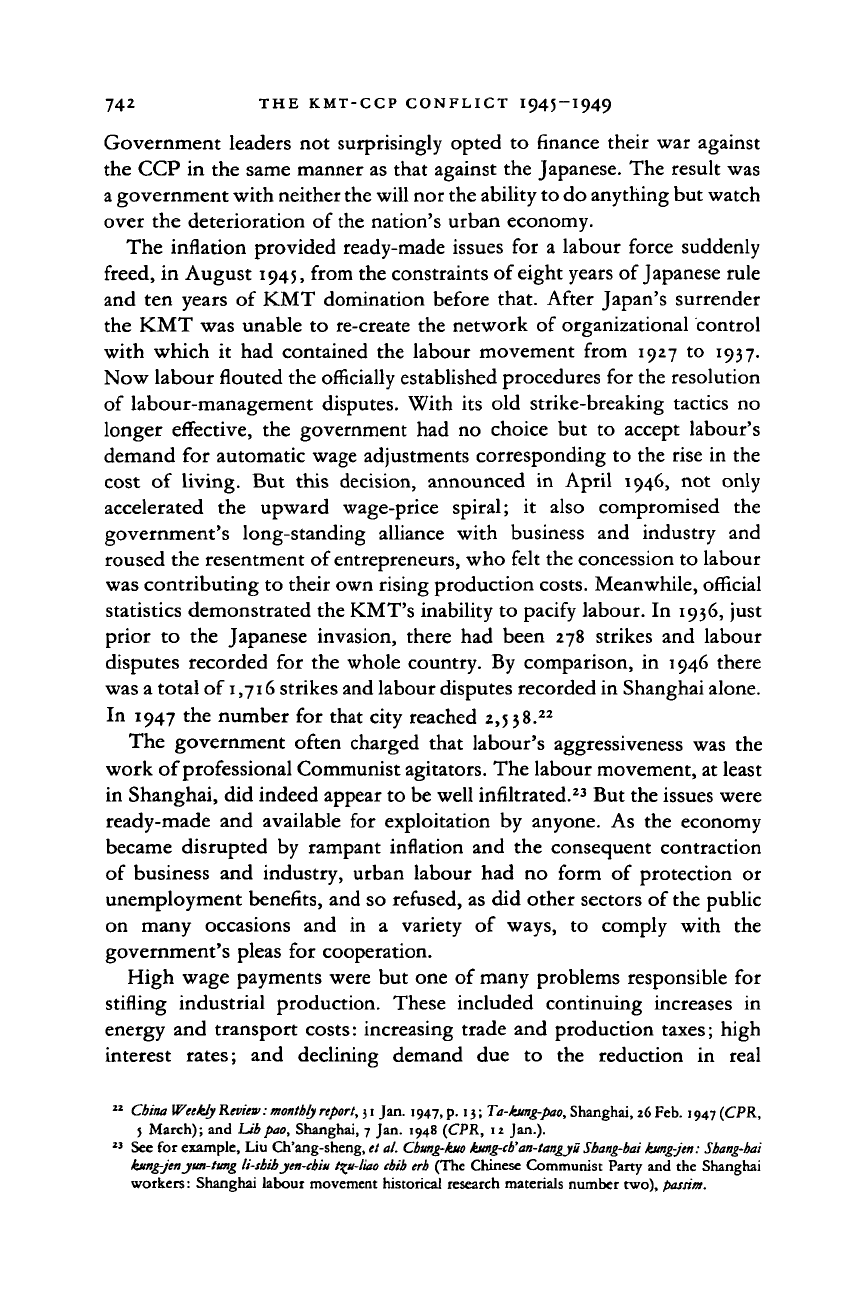
742 THE KMT-CCP CONFLICT I945-I949
Government leaders not surprisingly opted
to
finance their war against
the CCP in the same manner as that against the Japanese. The result was
a government with neither the will nor the ability to do anything but watch
over the deterioration of the nation's urban economy.
The inflation provided ready-made issues for a labour force suddenly
freed, in August 1945, from the constraints of eight years of Japanese rule
and ten years of KMT domination before that. After Japan's surrender
the KMT was unable to re-create the network of organizational control
with which
it
had contained the labour movement from 1927
to
1937.
Now labour flouted the officially established procedures for the resolution
of labour-management disputes. With its old strike-breaking tactics
no
longer effective, the government had no choice but
to
accept labour's
demand for automatic wage adjustments corresponding to the rise in the
cost
of
living. But this decision, announced
in
April 1946, not only
accelerated
the
upward wage-price spiral;
it
also compromised
the
government's long-standing alliance with business
and
industry and
roused the resentment of entrepreneurs, who felt the concession to labour
was contributing to their own rising production costs. Meanwhile, official
statistics demonstrated the KMT's inability to pacify labour. In 1936, just
prior
to
the Japanese invasion, there had been 278 strikes and labour
disputes recorded for the whole country. By comparison, in 1946 there
was a total of 1,716 strikes and labour disputes recorded in Shanghai alone.
In 1947 the number for that city reached 2,538."
The government often charged that labour's aggressiveness was the
work of professional Communist agitators. The labour movement, at least
in Shanghai, did indeed appear to be well infiltrated.
23
But the issues were
ready-made and available for exploitation by anyone. As the economy
became disrupted by rampant inflation and the consequent contraction
of business and industry, urban labour had
no
form
of
protection
or
unemployment benefits, and so refused, as did other sectors of the public
on many occasions
and in a
variety
of
ways,
to
comply with
the
government's pleas for cooperation.
High wage payments were but one of many problems responsible for
stifling industrial production. These included continuing increases
in
energy and transport costs: increasing trade and production taxes; high
interest rates;
and
declining demand
due to the
reduction
in
real
22
China Weekly Review: monthly report, 31 Jan. 1947, p. 13; Ta-hmg-pao, Shanghai, 26 Feb. 1947
(CPR,
5 March); and Ubpao, Shanghai, 7 Jan. 1948 (CPR, 12 Jan.).
23
See for example, Liu Ch'ang-sheng,
et
al. Cbung-kuo kimg-cb'an-tangju Sbang-bai kung-jen: Sbang-bai
kmg-jenjun-tung li-sbibjen-cbiu h(u-liao cbib erb (The Chinese Communist Party and
the
Shanghai
workers: Shanghai labour movement historical research materials number two), pashm.
Cambridge Histories Online © Cambridge University Press, 2008
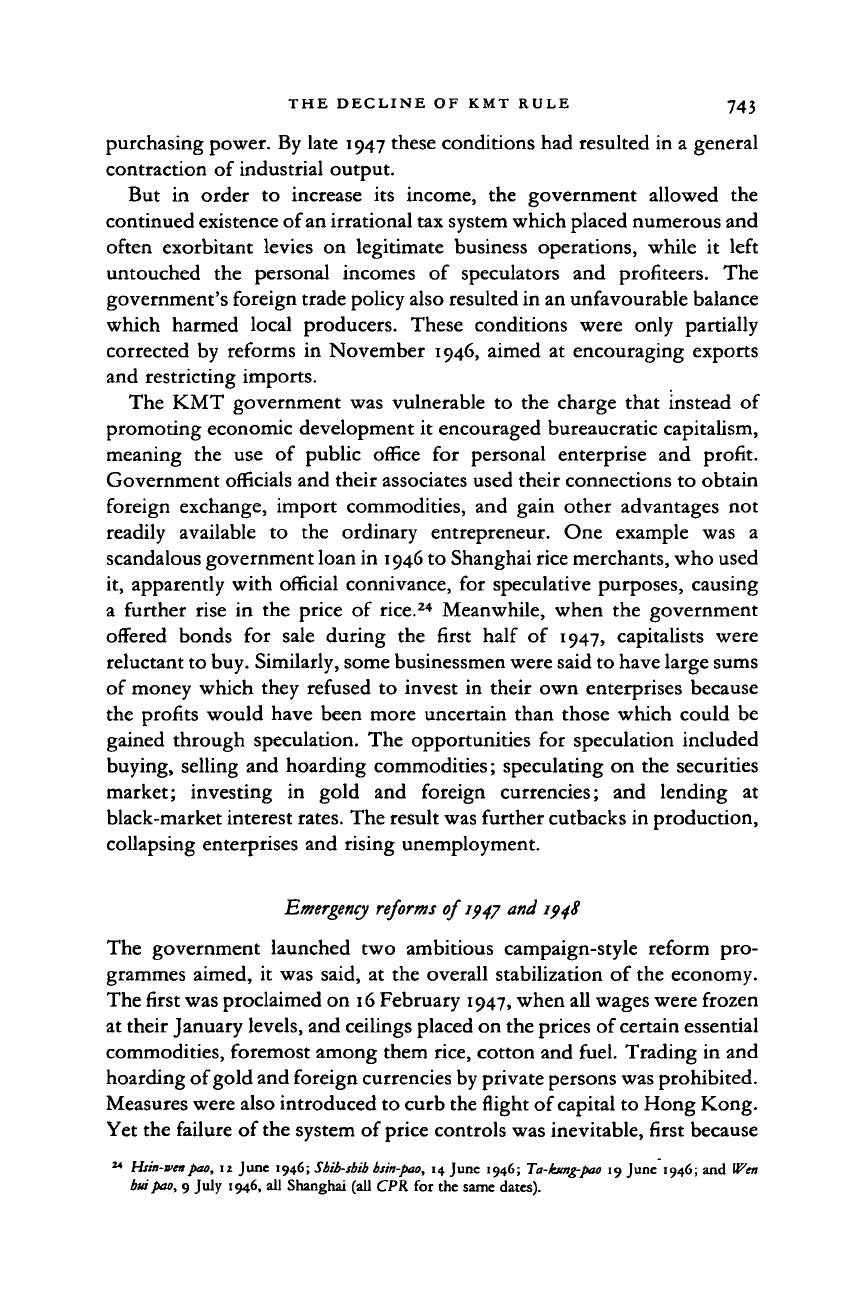
THE DECLINE
OF KMT
RULE
743
purchasing power. By late 1947 these conditions had resulted
in a
general
contraction
of
industrial output.
But
in
order
to
increase
its
income,
the
government allowed
the
continued existence of an irrational tax system which placed numerous and
often exorbitant levies
on
legitimate business operations, while
it
left
untouched
the
personal incomes
of
speculators
and
profiteers.
The
government's foreign trade policy also resulted in an unfavourable balance
which harmed local producers. These conditions were only partially
corrected
by
reforms
in
November 1946, aimed
at
encouraging exports
and restricting imports.
The KMT government
was
vulnerable
to the
charge that instead
of
promoting economic development
it
encouraged bureaucratic capitalism,
meaning
the use of
public office
for
personal enterprise
and
profit.
Government officials and their associates used their connections
to
obtain
foreign exchange, import commodities,
and
gain other advantages
not
readily available
to the
ordinary entrepreneur.
One
example
was a
scandalous government loan in 1946 to Shanghai rice merchants, who used
it, apparently with official connivance,
for
speculative purposes, causing
a further rise
in the
price
of
rice.
24
Meanwhile, when
the
government
offered bonds
for
sale during
the
first half
of 1947,
capitalists were
reluctant to buy. Similarly, some businessmen were said to have large sums
of money which they refused
to
invest
in
their
own
enterprises because
the profits would have been more uncertain than those which could
be
gained through speculation.
The
opportunities
for
speculation included
buying, selling
and
hoarding commodities; speculating
on the
securities
market; investing
in
gold
and
foreign currencies;
and
lending
at
black-market interest rates. The result was further cutbacks in production,
collapsing enterprises
and
rising unemployment.
Emergency
reforms
of
1947
and 1948
The government launched
two
ambitious campaign-style reform
pro-
grammes aimed,
it
was said,
at the
overall stabilization
of
the economy.
The first was proclaimed on
16
February
1947,
when all wages were frozen
at their January levels, and ceilings placed on the prices of certain essential
commodities, foremost among them rice, cotton and fuel. Trading
in
and
hoarding of gold and foreign currencies by private persons was prohibited.
Measures were also introduced to curb the flight of capital to Hong Kong.
Yet the failure
of
the system
of
price controls was inevitable, first because
24
Hsin-aenpao,
lz
June 1946; Sbib-sbib bsin-pao,
14
June 1946; Ta-kimg-pao
19
June 1946;
and Wen
buipao, 9 July 1946, all Shanghai (all CPR for the same dates).
Cambridge Histories Online © Cambridge University Press, 2008
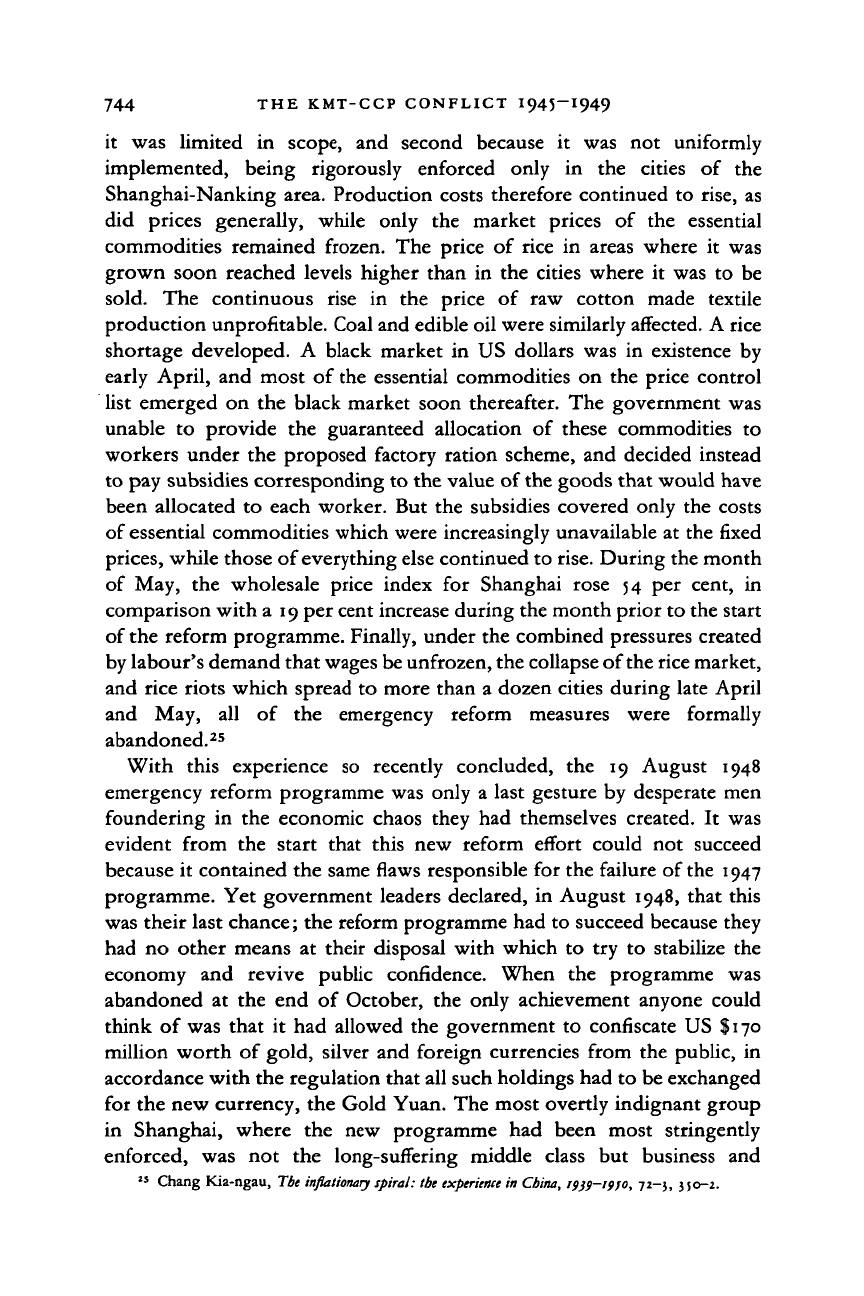
744 THE KMT-CCP CONFLICT I945-I949
it
was
limited
in
scope,
and
second because
it
was
not
uniformly
implemented, being rigorously enforced only
in the
cities
of the
Shanghai-Nanking area. Production costs therefore continued to rise, as
did prices generally, while only
the
market prices
of
the essential
commodities remained frozen. The price
of
rice
in
areas where
it
was
grown soon reached levels higher than in the cities where
it
was
to
be
sold. The continuous rise
in the
price
of
raw cotton made textile
production unprofitable. Coal and edible oil were similarly affected. A rice
shortage developed.
A
black market
in
US dollars was
in
existence by
early April, and most of the essential commodities on the price control
list emerged on the black market soon thereafter. The government was
unable
to
provide the guaranteed allocation
of
these commodities
to
workers under the proposed factory ration scheme, and decided instead
to pay subsidies corresponding to the value of the goods that would have
been allocated to each worker. But the subsidies covered only the costs
of essential commodities which were increasingly unavailable at the fixed
prices, while those of everything else continued to rise. During the month
of May, the wholesale price index
for
Shanghai rose 54 per cent,
in
comparison with a
19
per cent increase during the month prior to the start
of the reform programme. Finally, under the combined pressures created
by labour's demand that wages be unfrozen, the collapse of the rice market,
and rice riots which spread to more than a dozen cities during late April
and May,
all of the
emergency reform measures were formally
abandoned.
25
With this experience
so
recently concluded,
the 19
August 1948
emergency reform programme was only a last gesture by desperate men
foundering
in
the economic chaos they had themselves created.
It
was
evident from the start that this new reform effort could not succeed
because it contained the same flaws responsible for the failure of the 1947
programme. Yet government leaders declared, in August 1948, that this
was their last chance; the reform programme had to succeed because they
had no other means
at
their disposal with which to try
to
stabilize the
economy
and
revive public confidence. When
the
programme
was
abandoned
at
the end
of
October, the only achievement anyone could
think of was that
it
had allowed the government to confiscate US $170
million worth of gold, silver and foreign currencies from the public,
in
accordance with the regulation that all such holdings had to be exchanged
for the new currency, the Gold Yuan. The most overtly indignant group
in Shanghai, where
the
new programme had been most stringently
enforced, was
not the
long-suffering middle class
but
business
and
25
Chang Kia-ngau, The
inflationary
spiral:
the experience
in
China,
ifj?-/?jo, 72-3, 350-2.
Cambridge Histories Online © Cambridge University Press, 2008
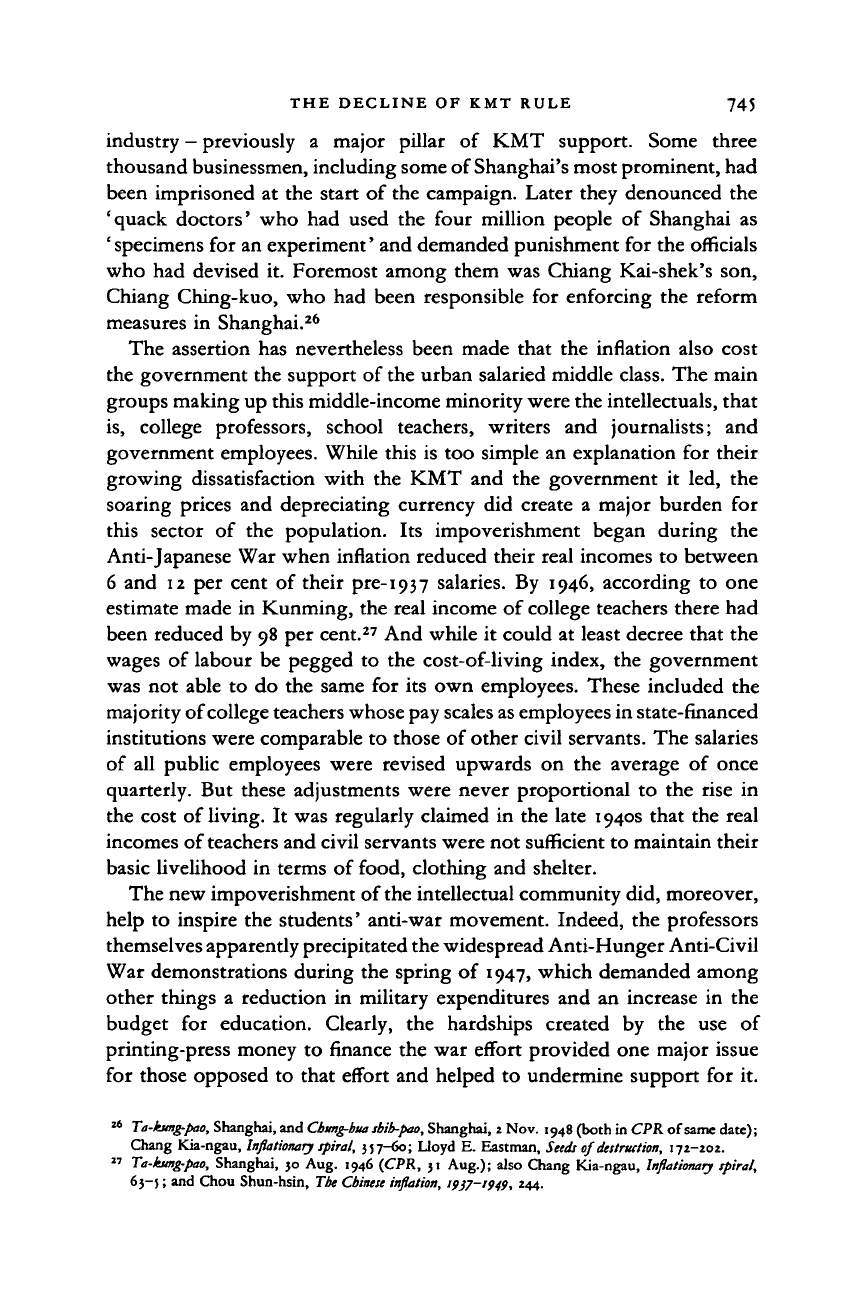
THE DECLINE OF KMT RULE 745
industry - previously a major pillar of KMT support. Some three
thousand businessmen, including some of Shanghai's most prominent, had
been imprisoned at the start of the campaign. Later they denounced the
'quack doctors' who had used the four million people of Shanghai as
' specimens for an experiment' and demanded punishment for the officials
who had devised it. Foremost among them was Chiang Kai-shek's son,
Chiang Ching-kuo, who had been responsible for enforcing the reform
measures in Shanghai.
26
The assertion has nevertheless been made that the inflation also cost
the government the support of the urban salaried middle class. The main
groups making up this middle-income minority were the intellectuals, that
is,
college professors, school teachers, writers and journalists; and
government employees. While this is too simple an explanation for their
growing dissatisfaction with the KMT and the government it led, the
soaring prices and depreciating currency did create a major burden for
this sector of the population. Its impoverishment began during the
Anti-Japanese War when inflation reduced their real incomes to between
6 and 12 per cent of their pre-1937 salaries. By 1946, according to one
estimate made in Kunming, the real income of college teachers there had
been reduced by 98 per cent.
27
And while it could at least decree that the
wages of labour be pegged to the cost-of-living index, the government
was not able to do the same for its own employees. These included the
majority of college teachers whose pay scales as employees in state-financed
institutions were comparable to those of other civil servants. The salaries
of all public employees were revised upwards on the average of once
quarterly. But these adjustments were never proportional to the rise in
the cost of living. It was regularly claimed in the late 1940s that the real
incomes of teachers and civil servants were not sufficient to maintain their
basic livelihood in terms of food, clothing and shelter.
The new impoverishment of the intellectual community did, moreover,
help to inspire the students' anti-war movement. Indeed, the professors
themselves apparently precipitated the widespread Anti-Hunger Anti-Civil
War demonstrations during the spring of 1947, which demanded among
other things a reduction in military expenditures and an increase in the
budget for education. Clearly, the hardships created by the use of
printing-press money to finance the war effort provided one major issue
for those opposed to that effort and helped to undermine support for it.
16
Ta-ksmg-pao, Shanghai, and Cbmg-bua sbib-pao, Shanghai, 2 Nov. 1948 (both in CPR of same date);
Chang Kia-ngau, Inflationary spiral,
3
57-60; Lloyd E. Eastman, Seeds of
destruction,
172-202.
17
Ta-hmg-pao, Shanghai, 30 Aug. 1946 (CPR, 31 Aug.); also Chang Kia-ngau, Inflationary spiral,
63-5;
and Chou Shun-hsin, Tie
Chinese
inflation, 19)7-1949, 244.
Cambridge Histories Online © Cambridge University Press, 2008

746 THE KMT-CCP CONFLICT I945-I949
But, even so, the intellectuals as
a
group, like the civil servants, did not
actually abandon the government until
it
was defeated militarily.
Political incompetence:
the
mismanagement
of
the peace movement
If their impoverishment was the main fact
of
economic life for China's
intellectuals during the 1940s, their dominant political preoccupation was
opposition to the civil war. The government refused to acknowledge the
legitimacy
of
this protest, treating
it
instead
as a
contrivance
of the
Communist underground. Because of this misconception and the repression
that followed therefrom,
it
was the government and not the CCP which
ultimately had to bear the heavier burden of public censure for the military
conflict.
Thus the student protest movement did not simply spring up full-blown
but developed
in the
course
of
the students' demonstrations
and the
government's reaction to them. There were four major demonstrations
which aroused nationwide attention.
The
December First movement
(1945) was the smallest of these. The principal action was
in
Kunming
where four young people were killed and several others seriously injured
on 1 December 1945 by unknown assailants attempting to intimidate the
anti-war protesters. As
a
result
of
this violent act, what had begun as
a
campus anti-war meeting at South-west Associated University came to be
known as the first major protest of the period. In late December 1946 and
January 1947,
a
series
of
anti-American demonstrations protested
the
alleged rape of a Peking University student by a US marine. The behaviour
of the marines was only the immediate provocation. Beyond that
the
students queried why American military personnel were
in
China
at all
and whether they were not in fact participants in the civil war on the side
of the government. The momentum generated over this issue grew into
the Anti-Hunger Anti-Civil
War
movement which swept through
universities and secondary schools
in
most major cities throughout the
country during May and June 1947. This last big 'student tide', as they
were called, merged with the Movement
to
Protest American Support
of Japan between April and June 1948.
Despite local concerns and personalities that were often involved, the
basic motivations of the national student protest were the same everywhere.
The students' primary demands were an immediate end to the civil war;
an end
to
US backing for the KMT
in
that war; and
a
shift
in
public
expenditure from military
to
civilian priorities. The government responded
initially
by
trying
to
divert the movement into other channels. Besides
the informers and secret agents planted by the authorities in schools where
Cambridge Histories Online © Cambridge University Press, 2008
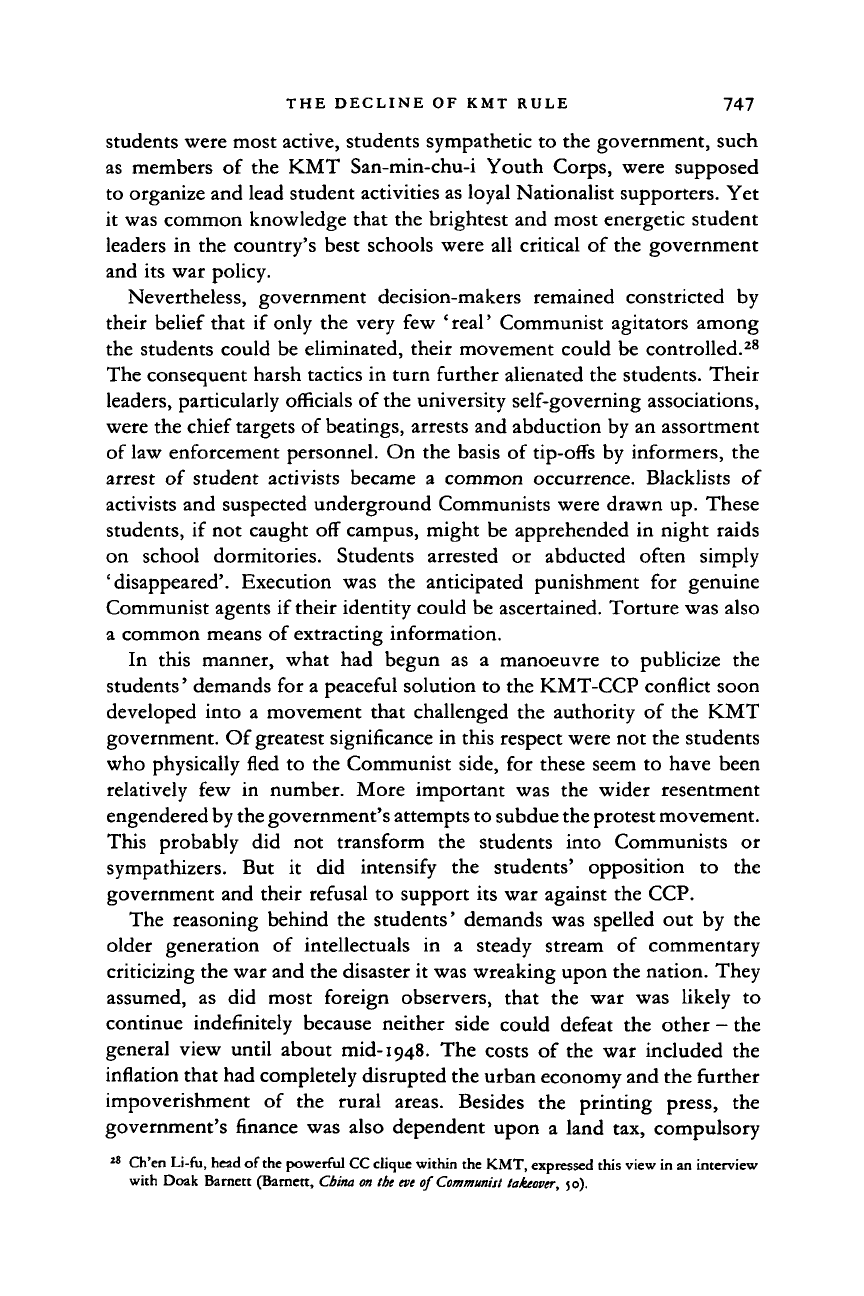
THE DECLINE OF KMT RULE 747
students were most active, students sympathetic to the government, such
as members
of
the KMT San-min-chu-i Youth Corps, were supposed
to organize and lead student activities as loyal Nationalist supporters. Yet
it was common knowledge that the brightest and most energetic student
leaders
in
the country's best schools were all critical
of
the government
and its war policy.
Nevertheless, government decision-makers remained constricted
by
their belief that
if
only the very few 'real' Communist agitators among
the students could be eliminated, their movement could be controlled.
28
The consequent harsh tactics in turn further alienated the students. Their
leaders, particularly officials of the university self-governing associations,
were the chief targets of beatings, arrests and abduction by an assortment
of law enforcement personnel. On the basis of tip-offs by informers, the
arrest
of
student activists became
a
common occurrence. Blacklists
of
activists and suspected underground Communists were drawn up. These
students,
if
not caught off campus, might be apprehended
in
night raids
on school dormitories. Students arrested
or
abducted often simply
'disappeared'. Execution was
the
anticipated punishment
for
genuine
Communist agents if their identity could be ascertained. Torture was also
a common means of extracting information.
In this manner, what
had
begun
as a
manoeuvre
to
publicize
the
students' demands for a peaceful solution to the KMT-CCP conflict soon
developed into
a
movement that challenged the authority
of
the KMT
government. Of greatest significance in this respect were not the students
who physically fled
to
the Communist side, for these seem
to
have been
relatively
few in
number. More important was
the
wider resentment
engendered by the government's attempts to subdue the protest movement.
This probably
did not
transform
the
students into Communists
or
sympathizers.
But it did
intensify
the
students' opposition
to the
government and their refusal to support its war against the CCP.
The reasoning behind the students' demands was spelled out
by
the
older generation
of
intellectuals
in a
steady stream
of
commentary
criticizing the war and the disaster it was wreaking upon the nation. They
assumed,
as did
most foreign observers, that
the war
was likely
to
continue indefinitely because neither side could defeat
the
other
-
the
general view until about mid-1948. The costs
of
the war included
the
inflation that had completely disrupted the urban economy and the further
impoverishment
of the
rural areas. Besides
the
printing press,
the
government's finance was also dependent upon
a
land tax, compulsory
28
Ch'en Li-fti, head of the powerful CC clique within the KMT, expressed this view in an interview
with Doak Barnett (Barnett, China on the ere
of
Communist takeover, 50).
Cambridge Histories Online © Cambridge University Press, 2008
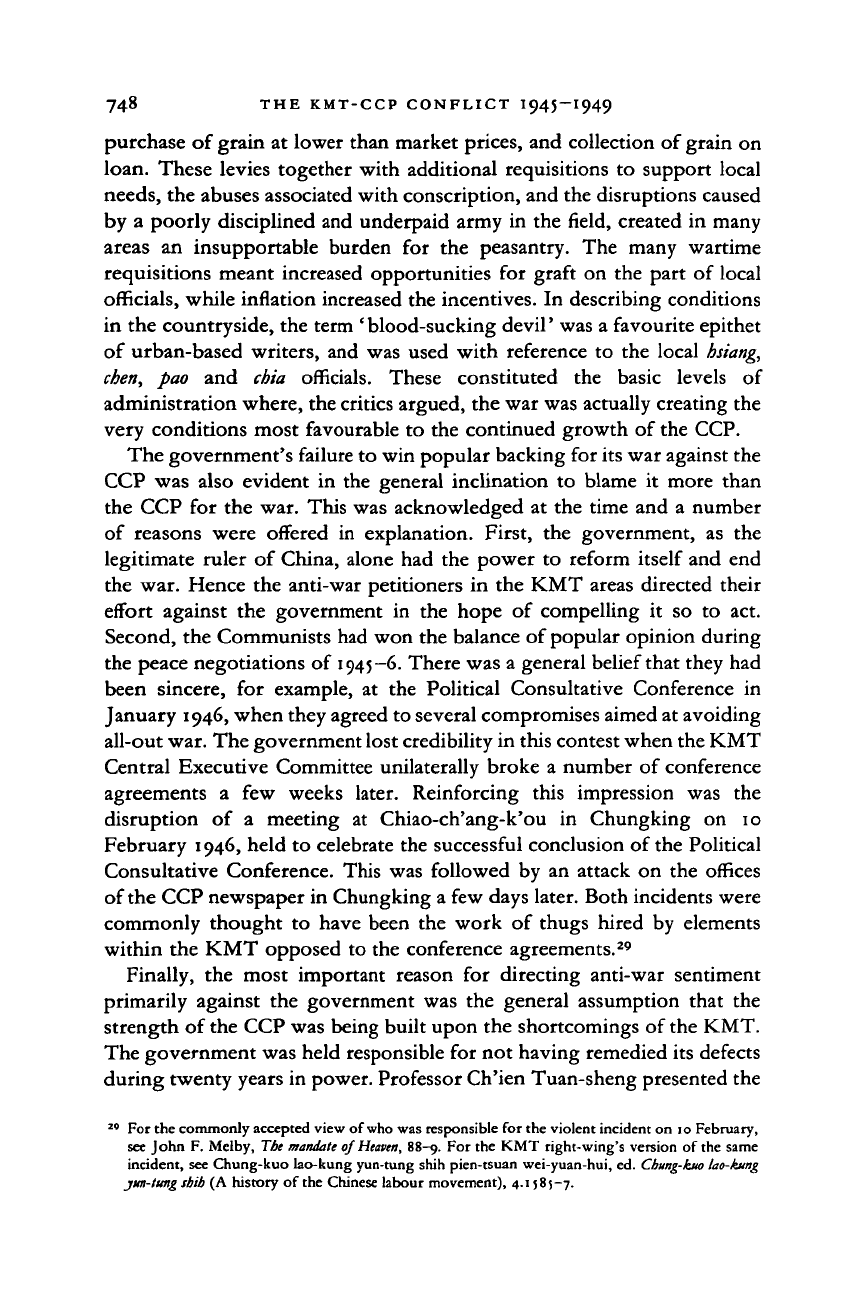
748 THE KMT-CCP CONFLICT I945-I949
purchase of grain at lower than market prices, and collection of grain on
loan. These levies together with additional requisitions to support local
needs,
the abuses associated with conscription, and the disruptions caused
by
a
poorly disciplined and underpaid army in the field, created in many
areas
an
insupportable burden
for
the peasantry. The many wartime
requisitions meant increased opportunities for graft on the part of local
officials, while inflation increased the incentives. In describing conditions
in the countryside, the term ' blood-sucking devil' was a favourite epithet
of urban-based writers, and was used with reference to the local
hsiang,
chen,
pao
and
chia officials. These constituted
the
basic levels
of
administration where, the critics argued, the war was actually creating the
very conditions most favourable to the continued growth of the CCP.
The government's failure to win popular backing for its war against the
CCP was also evident in the general inclination to blame
it
more than
the CCP for the war. This was acknowledged at the time and
a
number
of reasons were offered
in
explanation. First, the government,
as
the
legitimate ruler of China, alone had the power to reform itself and end
the war. Hence the anti-war petitioners in the KMT areas directed their
effort against the government
in
the hope
of
compelling
it so to
act.
Second, the Communists had won the balance of popular opinion during
the peace negotiations of 1945-6. There was a general belief that they had
been sincere,
for
example,
at
the Political Consultative Conference
in
January 1946, when they agreed to several compromises aimed at avoiding
all-out war. The government lost credibility in this contest when the KMT
Central Executive Committee unilaterally broke a number of conference
agreements
a few
weeks later. Reinforcing this impression was
the
disruption
of a
meeting
at
Chiao-ch'ang-k'ou
in
Chungking
on 10
February 1946, held to celebrate the successful conclusion of the Political
Consultative Conference. This was followed by an attack on the offices
of the CCP newspaper in Chungking a few days later. Both incidents were
commonly thought
to
have been the work
of
thugs hired by elements
within the KMT opposed to the conference agreements.
29
Finally, the most important reason
for
directing anti-war sentiment
primarily against the government was the general assumption that the
strength of the CCP was being built upon the shortcomings of the KMT.
The government was held responsible for not having remedied its defects
during twenty years in power. Professor Ch'ien Tuan-sheng presented the
29
For the commonly accepted view of
who
was responsible for the violent incident on 10 February,
see John F. Melby, The
mandate
ofHtaeeti,
88-9. For the KMT right-wing's version of the same
incident, see Chung-kuo lao-kung yun-tung shih pien-tsuan wei-yuan-hui, ed.
Cbung-kuo lao-kung
jm-tung
sbib
(A history of the Chinese labour movement), 4.1585-7.
Cambridge Histories Online © Cambridge University Press, 2008
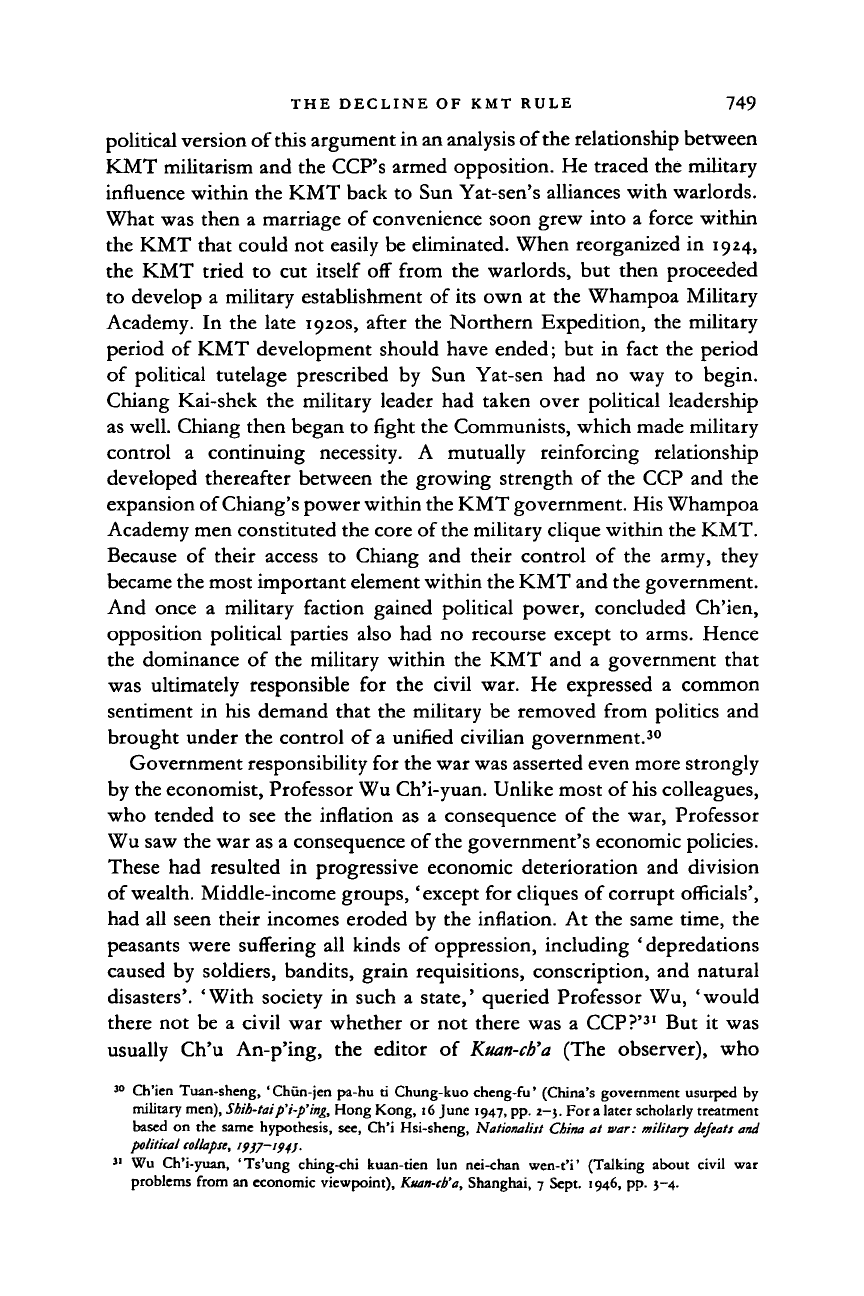
THE DECLINE OF KMT RULE 749
political version of this argument in an analysis of the relationship between
KMT militarism and the CCP's armed opposition. He traced the military
influence within the KMT back to Sun Yat-sen's alliances with warlords.
What was then
a
marriage of convenience soon grew into
a
force within
the KMT that could not easily be eliminated. When reorganized in 1924,
the KMT tried
to
cut itself
off
from the warlords, but then proceeded
to develop
a
military establishment of its own
at
the Whampoa Military
Academy.
In
the late 1920s, after the Northern Expedition, the military
period
of
KMT development should have ended; but
in
fact the period
of political tutelage prescribed
by
Sun Yat-sen
had no
way
to
begin.
Chiang Kai-shek the military leader had taken over political leadership
as well. Chiang then began to fight the Communists, which made military
control
a
continuing necessity.
A
mutually reinforcing relationship
developed thereafter between the growing strength
of
the CCP and the
expansion of Chiang's power within the KMT government. His Whampoa
Academy men constituted the core of the military clique within the KMT.
Because
of
their access
to
Chiang and their control
of
the army, they
became the most important element within the KMT and the government.
And once
a
military faction gained political power, concluded Ch'ien,
opposition political parties also had
no
recourse except
to
arms. Hence
the dominance
of
the military within the KMT and
a
government that
was ultimately responsible
for
the civil war.
He
expressed
a
common
sentiment
in
his demand that the military be removed from politics and
brought under the control of a unified civilian government.
30
Government responsibility for the war was asserted even more strongly
by the economist, Professor Wu Ch'i-yuan. Unlike most of
his
colleagues,
who tended
to
see the inflation
as a
consequence
of
the war, Professor
Wu saw the war as a consequence of the government's economic policies.
These had resulted
in
progressive economic deterioration and division
of
wealth.
Middle-income groups,' except for cliques of corrupt officials',
had all seen their incomes eroded by the inflation. At the same time, the
peasants were suffering all kinds
of
oppression, including ' depredations
caused by soldiers, bandits, grain requisitions, conscription, and natural
disasters'. 'With society
in
such
a
state,' queried Professor Wu, 'would
there not be
a
civil war whether
or
not there was
a
CCP?'
31
But
it
was
usually
Ch'u
An-p'ing,
the
editor
of
Kuan-ch'a
(The observer),
who
30
Ch'ien Tuan-sheng,
'
Chun-jen pa-hu
ti
Chung-kuo cheng-fu' (China's government usurped
by
military men), Sbih-taip'i-p'ing, Hong Kong, 16 June 1947, pp. 2-j. For
a
later scholarly treatment
based
on the
same hypothesis, see, Ch'i Hsi-sheng, Nationalist China
at
war: military defeats and
political
collapse,
1937-194; •
31
Wu
Ch'i-yuan, 'Ts'ung ching-chi kuan-tien
lun
nei-chan wen-t'i' (Talking about civil
war
problems from an economic viewpoint),
Kuan-cb'a,
Shanghai,
7
Sept. 1946, pp. 5-4.
Cambridge Histories Online © Cambridge University Press, 2008
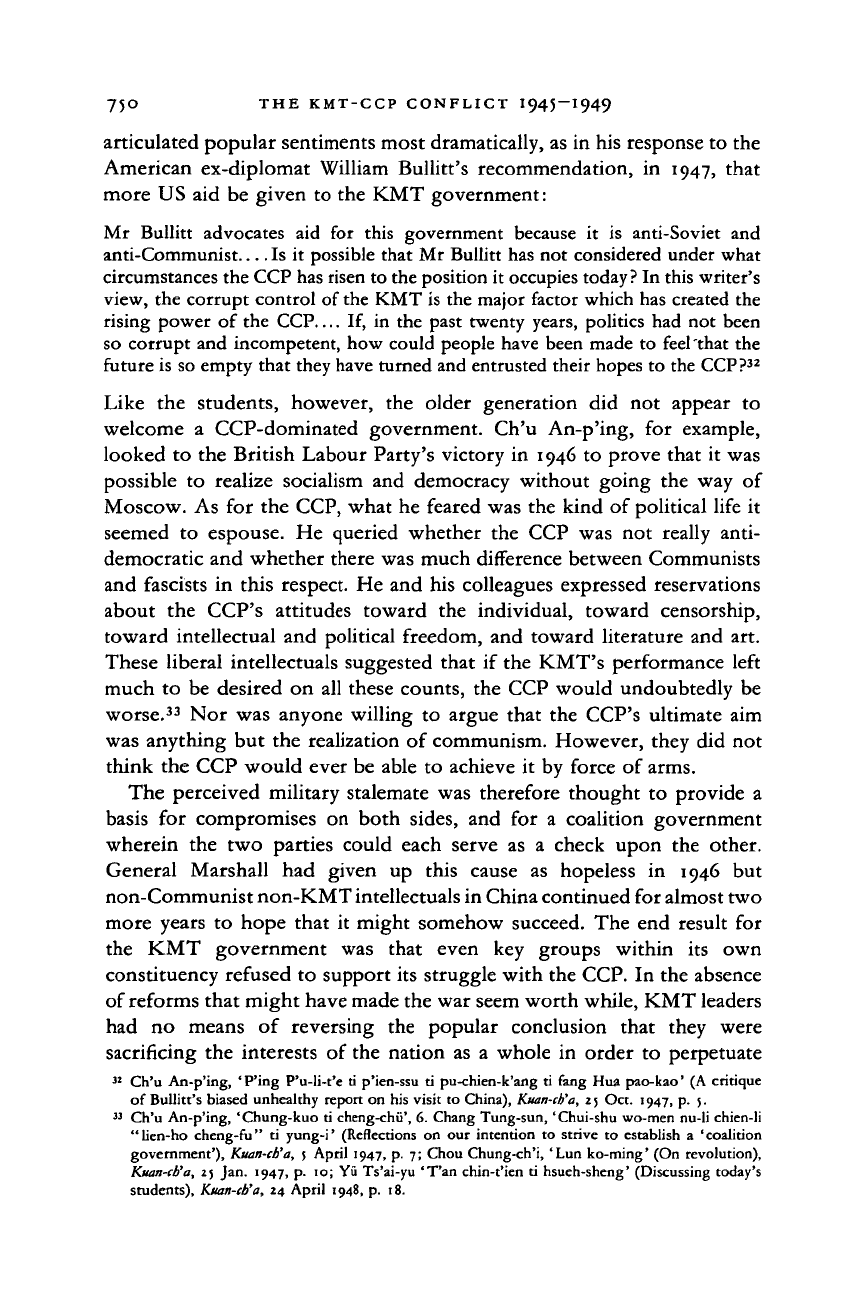
75O THE KMT-CCP CONFLICT I945-I949
articulated popular sentiments most dramatically, as in his response to the
American ex-diplomat William Bullitt's recommendation,
in
1947, that
more US aid be given to the KMT government:
Mr Bullitt advocates
aid for
this government because
it is
anti-Soviet and
anti-Communist Is it possible that Mr Bullitt has not considered under what
circumstances the CCP has risen to the position it occupies today? In this writer's
view, the corrupt control of the KMT is the major factor which has created the
rising power of the CCP
If,
in the past twenty years, politics had not been
so corrupt and incompetent, how could people have been made to feel "that the
future is so empty that they have turned and entrusted their hopes to the CCP?
32
Like
the
students, however,
the
older generation
did not
appear
to
welcome
a
CCP-dominated government. Ch'u An-p'ing,
for
example,
looked to the British Labour Party's victory in 1946 to prove that
it
was
possible
to
realize socialism and democracy without going the way
of
Moscow. As for the CCP, what he feared was the kind of political life
it
seemed
to
espouse.
He
queried whether the CCP was
not
really anti-
democratic and whether there was much difference between Communists
and fascists
in
this respect. He and his colleagues expressed reservations
about
the
CCP's attitudes toward
the
individual, toward censorship,
toward intellectual and political freedom, and toward literature and art.
These liberal intellectuals suggested that
if
the KMT's performance left
much
to
be desired on all these counts, the CCP would undoubtedly
be
worse.
33
Nor was anyone willing
to
argue that the CCP's ultimate aim
was anything but the realization of communism. However, they did not
think the CCP would ever be able to achieve
it
by force of arms.
The perceived military stalemate was therefore thought
to
provide
a
basis
for
compromises
on
both sides,
and for a
coalition government
wherein
the
two parties could each serve
as a
check upon
the
other.
General Marshall
had
given
up
this cause
as
hopeless
in
1946
but
non-Communist non-KMT intellectuals in China continued for almost two
more years
to
hope that
it
might somehow succeed. The end result
for
the
KMT
government
was
that even
key
groups within
its own
constituency refused to support its struggle with the CCP. In the absence
of reforms that might have made the war seem worth while, KMT leaders
had
no
means
of
reversing
the
popular conclusion that they were
sacrificing the interests
of
the nation
as a
whole
in
order
to
perpetuate
32
Ch'u An-p'ing,
'
P'ing P'u-li-t'e
ti
p'ien-ssu
ti
pu-chien-k'ang
ti
fang Hua pao-kao' (A critique
of Bullitt's biased unhealthy report on his visit to China),
Kuan-cb'a,
25 Oct. 1947, p.
5.
33
Ch'u An-p'ing, ' Chung-kuo
ti
cheng-chii', 6. Chang Tung-sun,' Chui-shu wo-men nu-li chien-li
"lien-ho cheng-fu"
ti
yung-i' (Reflections
on
our intention
to
strive
to
establish
a
'coalition
government'),
Kuan-cb'a,
5 April 1947, p. 7; Chou Chung-ch'i, 'Lun ko-ming' (On revolution),
Kuan-cb'a,
25 Jan. 1947, p. 10; Yu Ts'ai-yu 'T'an chin-t'ien
ti
hsueh-sheng' (Discussing today's
students),
Kuan-cb'a,
24 April 1948, p. 18.
Cambridge Histories Online © Cambridge University Press, 2008
